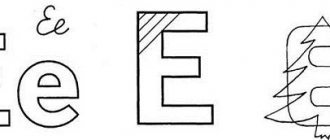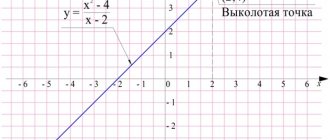Solving triangles
Today in the lesson we will summarize our knowledge in the section “Relationships between the sides and angles of a triangle.”
Before we begin solving problems, let's remember the main theoretical material of this topic.
Formula for calculating the area of a triangle:
Cosine theorem:
Theorem of sines:
The sides of a triangle are proportional to the sines of the opposite angles.
Extended sine theorem:
Solve triangle
- this means finding all its elements (three sides and three angles) using some known three elements that define the triangle.
Problems of this type include the following tasks: solving a triangle using three sides; solving a triangle using three angles; solving a triangle using two sides and the angle between them; solving a triangle using two sides and an angle not lying between them; solving a triangle by side and adjacent angles; solving triangles by side and arbitrary two angles.
Let us consider each type of such tasks separately.
Let's start by solving a triangle using three angles.
Let's write down the theorem of sines and cosines and think about which of them can be used to solve a triangle.
Both of these theorems contain the lengths of the sides, so knowing only the angles of a triangle cannot find the lengths of the sides of the triangle.
Let's now try to solve the triangle using three sides.
Knowing the lengths of all sides of a triangle, using the cosine theorem you can find the cosines of all angles of the triangle. And, knowing the cosine of an angle, it is not difficult to find the angle itself. To do this, you can use either a calculator or Bradis tables.
This means that in this case the triangle can be solved using the cosine theorem.
Let's look at an example.
Task.
Find the angles of a triangle if the sides of the triangle are 25, 20, 17.
Solution.
Answer:
; ; .
Next we will look at solving a triangle using a side and its adjacent angles.
We immediately notice that the third angle is not difficult to find; it is equal to the difference between 180° and the known angles.
Let's write down the theorem of sines.
From each equality, we can find the side of the triangle. Thus, knowing the length of one side and the size of two angles adjacent to it, you can find all the other elements of the triangle using the theorem of sines.
Task.
Solve a triangle if one of the sides of the triangle is equal to , and the angles adjacent to this side are equal to and °, respectively.
Solution.
Answer:
.
Task.
Solve a triangle if its two sides are equal to cm and cm, respectively, and the angle between them is equal to .
Solution.
Answer:
.
Now let's see if it is possible to solve a triangle if we know two sides and an angle that does not lie between them.
Yes, you can. To do this, using the sine theorem, you need to find the second angle of the triangle, and then the third angle, and using the cosine theorem, find the third side of the triangle.
That is, in this case, the triangle can be solved using the sine theorem or the cosine theorem.
Task.
Solve a triangle if two of its sides are equal to and , and one of the angles not lying between these sides is equal to .
Solution.
Answer:
.
So let's summarize.
If the values of the three angles in a triangle are known, then it cannot be solved.
If three sides are known in a triangle, then such a triangle can be solved using the cosine theorem.
If a triangle has a side and any two angles, then such a triangle can be solved using the sine theorem.
If two sides of a triangle and the angle between them are known, then such a triangle can be solved using the cosine theorem or the sine theorem.
If we know two sides and any angle that does not lie between them, then the triangle can be solved using the theorem of sines and cosines.
Summary of an open lesson on the topic “Solving triangles” (9th grade)
Lesson topic.
"Solving Triangles"
Class 9
Lesson date: 12/05/2017
Lesson objectives.
Educational. Practice skills in solving standard problems using the theorems of sines, cosines, and the Pythagorean theorem.
Educating. Cultivating learning motives and a positive attitude towards knowledge.
Developmental. Development of will and independence (development of initiative, self-confidence; development of perseverance, the ability to overcome difficulties to achieve the intended goal; development of the ability to control oneself - endurance, self-control; development of the ability to act independently).
Lesson type: lesson on systematization and generalization of knowledge and skills
DURING THE CLASSES
I. Introductory part – 3 min.
Triangle... Familiar to you from childhood, and starting from 7th grade, from geometry lessons, a geometric figure is fraught with a lot of interesting and mysterious things, like the Bermuda Triangle, in which ships and planes disappear without a trace. The familiar shapes square, parallelogram, rectangle, rhombus, trapezoid consist of two triangles if you draw one diagonal and four triangles if you draw two diagonals. In grades 10-11, solving triangles is also used, so you should learn how to solve any triangle. Before solving problems, let’s review the topic “Solving triangles.”
Conditions:
• be attentive and quick-witted;
• do not leave any question unanswered;
• for each task there is a minimum of time, but a maximum of diligence;
• do not peep, do not eavesdrop, do not disturb your neighbors.
II. Repetition.
- What is called solving triangles?
- What theorems apply to solving triangles?
- State the sine theorem? The cosine theorem?
- What is the sum of the angles of a triangle?
- What tasks can be identified?
(on a side and two angles adjacent to it; on two sides and the angle between them; on three sides; on a side, an angle adjacent to it and the side opposite to a given angle)
- Write down, using the cosine theorem, the square of the side of triangle ABC if: 1) =600; 2) =300; 3) =450. (c2=a2+b2-av; c2=a2+b2-av; c2=a2+b2-av)
- What is it equal to? ()
8.. How to determine the type of triangle using the cosine theorem? (it is enough to determine the sign of the cosine corresponding to the largest angle; if side a is the largest, then it is enough to determine the sign of the quantity b2 + c2-a2)
9. In a triangle KLN, KL=8.4 cm, LN=13.2 cm, KN=7.5 cm. Which angle of the triangle is the largest and which is the smallest?
10. The sides of the triangle are 10cm, 12cm, 7cm. Can an angle opposite to a side of 7 cm be obtuse? Why?
11. The sides of the triangle are 9cm and 12cm. Can an angle opposite to a side equal to 9cm be right? Why?
III. Working with signal cards.
A test to determine the truth (falsity) of a statement and the correctness of the wording.
- In a triangle, the longest side lies opposite an angle of 150°. (AND)
- In an equilateral triangle, the interior angles are equal to each other and each is equal to 60°. (I)
- There is a triangle with sides: 2 cm, 7 cm, 3 cm. (L)
- A right isosceles triangle has equal sides. (AND)
- The sum of the lengths of two sides of any triangle is less than the third side. (L)
- If the acute angle of a right triangle is 60°, then the adjacent leg is equal to half the hypotenuse. (AND)
- There is a triangle with two obtuse angles. (L)
- In a right triangle, the sum of the acute angles is 90°. (I)
VI. Practicing formulas.
Find the error in your friend's answer:
1) A
2 =
in 2 + c 2 + 2vc cos 4)
2) in 2
= a 2 + c 2 – 2vc cos
5)
3) a2
=
a 2 + c 2 - 2ac sin
6)
III Solving repetition problems. 2 students online test.
Solving problems by levels:
Group 1: level C
Task:
In triangle ABC, angle B is equal to 600. The bisector of angle B intersects side AC at point D; BP=4cm, BP=6cm. Find the angles of triangle ABC and its side AC.
Solution:
Group 2: level B
Task:
In triangle ABC, AB=0.6cm, BC=0.5cm, . Find the AC side.
Solution:
Group 3: level A
Task:
In triangle ABC, AB=10cm, . Find the AC side.
Solution:
IV Historical background:
Why are these tasks needed? In Ancient Greece, along with the brilliant development of theoretical geometry, scientific research methods and logical proofs, applied geometry was of great importance. The Romans generally dealt with only one practical and applied side of mathematics, necessary for land surveying, city construction, technical and military structures.
The thread of practical geometry stretched from the Babylonians and ancient Egyptians through Heron until modern times.
In the 16th and 17th centuries, increasingly developing industry and trade required satisfaction, first of all, of practical needs. The appearance of the first instruments and apparatus for scientific research (thermometer, telescope, barometer, microscope, etc.) aroused interest in the practical side of science and especially in practical geometry, which was needed for military purposes, navigation, construction and land surveying. During this period, many manuals on geometry appeared, which set out rules, formulas and recipes for solving certain practical problems.
Task No. 1. To decorate a 6 m high New Year tree, two metal half rings were driven into the ground on two opposite sides at a distance of 4 m from the tree. What should be the length of the cables stretched from the top of the tree to the half rings? Neglect the radius of the rings. Find the angle of inclination of the cable.
Problem No. 2. A fire escape standing on a car can be extended by 20 m, and its steepness can reach 700. The base of the ladder is at a height of 2 m. Which floor can be reached by it if the height of the floor is 3 m?
Problem No. 3. A sports plane flies along a closed triangular route. Two angles of this triangle are equal to 600 and 1000. He flew the side opposite the third angle in 1 hour. How long will it take him to cover the entire route, maintaining a constant speed?
Solution
Answer: in 4 hours the plane will fly the entire route.
Problem No. 4. Find the length of the segment at the ends of which the legs of the measuring compass rest, 15 cm long, if they form an angle of 300.
Solution Answer: 7.8 cm.
V. Summing up the lesson
.
cinquain -
a poem according to an algorithm:
- develops the poetic abilities of students.
Let’s end the lesson with the words of the great Italian scientist Galileo Galilei: “Geometry is the most powerful means for refining our mental abilities and makes it possible to think and reason correctly.”
VI .
Homework assignment. 1.
Determine the most economical use of cable to strengthen the tree.
2. 3rd level:
Task:
“Two planks 35cm and 42cm long are fastened at one end. What angle should be taken between them so that the distance between the other ends of the planks is 24 cm?
Level 2:
Task:
“Two planks 35cm and 42cm long are fastened at one end. What angle between them should be taken so that the distance between the other ends of the planks is 24 cm? Can this distance for any angle be equal to 5cm; 80cm?
Level 1:
Task:
At 12:00 the offender turned off the main highway and rushed along the highway at a speed of 140 km/h. At 12:00 a traffic police inspector rushed along the country road at a speed of 70 km/h to cut off the violator. Will the inspector have time to stop the violator at the intersection of the highway and the country road?
In Ancient Greece, along with the brilliant development of theoretical geometry, scientific research methods and logical proofs, applied geometry was of great importance. The Romans generally dealt with only one practical and applied side of mathematics, necessary for land surveying, city construction, technical and military structures.
The thread of practical geometry stretched from the Babylonians and ancient Egyptians through Heron until modern times.
In the 16th and 17th centuries, increasingly developing industry and trade required satisfaction, first of all, of practical needs. The appearance of the first instruments and apparatus for scientific research (thermometer, telescope, barometer, microscope, etc.) aroused interest in the practical side of science and especially in practical geometry, which was needed for military purposes, navigation, construction and land surveying. During this period, many manuals on geometry appeared, which set out rules, formulas and recipes for solving certain practical problems.







